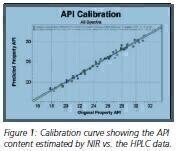Chromatography
On-line Estimation of the API Content in Tablets Using NIR Spectroscopy
Jun 09 2010
Process analytical technology (PAT) has been mentioned over the last few years, the aim is to design and develop well understood manufacturing processes that will consistently ensure a predefined quality at the end of the manufacturing process. Near Infrared (NIR) spectroscopy is one of the most powerful tools for PAT due to its major advantages: it is a fast and nondestructive analysis method. To address this field Buchi cooperates with competent and well established partners in order to deliver the best solution to our customers. Starting with the verification of material‘s identity up to on-line tablet analysis and final release tests Buchi technology covers all. This short report concentrates on the on-line analysis of tablets by NIR transmission measurements. During tabletting it is essential to monitor and control all quality relevant parameters
like compression force, weight, thickness, diameter, hardness and API content. Until now practically only compression force and the physical parameters are monitored on-line and are used partly for a control loop. The API content is normally determined using HPLC after finishing the batch. This procedure provides a too late determination of out of specification batches. During the last years NIR measurements have been used replacing HPLC, which are much faster and deliver reliability and accuracy comparable to HPLC. However the measurements are still performed after finishing the production of the batch. In order to receive early fault detection, the API content during manufacturing needs to be estimated on-line. The obvious benefits are improved quality as well as real time process information, understanding and control.
With NIR spectroscopy tablets can be investigated either in reflection or in transmission mode. Modern tablets often involve multi-layer or other complex designs. In order to collect the information from the complete cross-section transmission measurements are required. This goal is achieved by integrating the robust Buchi NIRFlex N-500 FT-NIR spectrometer with the Solids Transmittance module into the proven Checkmaster from Fette Compacting (Schwarzenbek, Germany). As NIR spectroscopy is a secondary analytical method, a calibration is needed. Proper calibration curve requires the measurement of a considerable number of samples, from which the API contents have been determined by a primary analytical method (HPLC). For efficient calibration development a laboratory based NIR spectrometer will be used. During an extensive application study calibrations of a pharmaceutical manufacturer were developed on a laboratory spectrometer and transferred to the on-line system. Figure 1 shows the calibration curve indicating the excellent agreement between NIR and HPLC reference values. Figure 2 demonstrates the outstanding calibration transfer from a laboratory based NIR spectrometer to the on-line “NIR Checkmaster” system.
Both figures demonstrate that NIR is capable of delivering reliable and accurate results in a laboratory as well as an on-line environment.
Digital Edition
Lab Asia Dec 2025
December 2025
Chromatography Articles- Cutting-edge sample preparation tools help laboratories to stay ahead of the curveMass Spectrometry & Spectroscopy Articles- Unlocking the complexity of metabolomics: Pushi...
View all digital editions
Events
Jan 21 2026 Tokyo, Japan
Jan 28 2026 Tokyo, Japan
Jan 29 2026 New Delhi, India
Feb 07 2026 Boston, MA, USA
Asia Pharma Expo/Asia Lab Expo
Feb 12 2026 Dhaka, Bangladesh






















